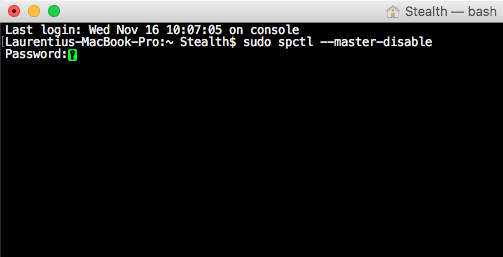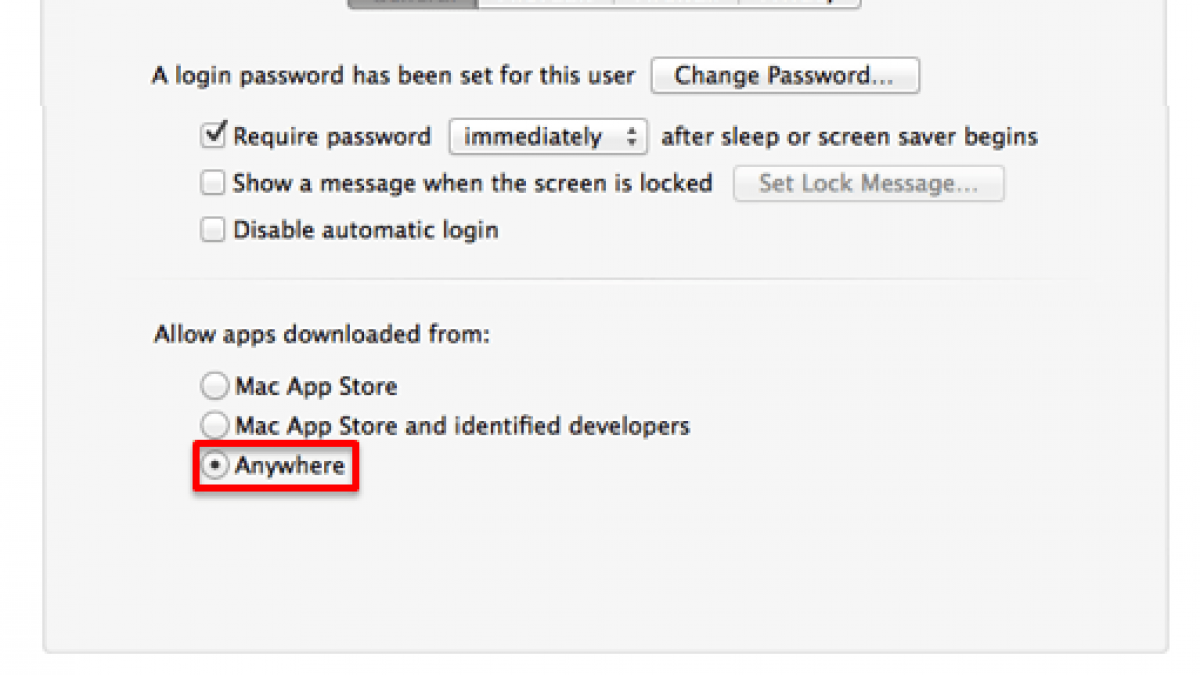- Allow Apps Downloaded From Anywhere Mac Catalina Os
- Allow Apps Downloaded From Anywhere Mac Catalina Free
If you’ve ever tried to open an app from an unidentified developer on your Mac, you know that it can be a tricky task. macOS has security measures in place that block this action in the hopes of protecting you from malware. That being said, it’s not impossible.
Here, we’ll talk about apps from unidentified developers and show you how to allow them on your Mac. We’ll also go over some tips for staying safe when downloading new software.
The Allow to Control Remotely command is available only if attendees have the Control shared applications, Web browser, ordesktop remotely privilege. Advanced Mac users may wish to allow a third option, which is the ability to open and allow apps downloaded from anywhere in MacOS Catalina, macOS Sierra, macOS High Sierra, and MacOS Mojave. Even though Gatekeeper in macOS is now stricter than ever, there is a way around it - including macOS Catalina's newest tools. The workaround makes it possible to download and use apps downloaded from anywhere on macOS Catalina and earlier versions without a check. First published in 2016 by OSX Daily, but still valid, the 'fix' works like this. However, if you would like to change the security settings of your Mac (as far as app launching is concerned), then you will have to disable Gatekeeper and turn on Allow apps downloaded from to: Anywhere. How to Allow All Unknown Apps to Open on Mac Running macOS Catalina. Open Terminal on your Mac by going into Launchpad – Other. In order to remotely control your customer's Mac running macOS Catalina, the steps below must be performed on the customer's Mac. You can connect to your customer's Mac in a view-only session and walk them through the steps using Chat, or send them these instructions to perform on their own. Mac System Preferences Allow App.

What is an unidentified developer?
Allow Apps Downloaded From Anywhere. TotalFinder works by altering the built-in system application Finder.app. Macos Catalina Allow Apps From Anywhere Internet. In order to change some features of Finder, we use a technique called code injection. This means we add some additional code to the Finder program whilst it is running to do what we need.
An unidentified developer is an app developer that isn’t registered with Apple. Generally, apps from unidentified developers haven’t been reviewed by Apple for safety and security.
Apple believes that one of the easiest ways to distribute malware is to insert its code into an app. That’s why they check apps thoroughly before allowing them to release to the Mac App Store. Apps from unidentified developers aren’t on the App Store.
This doesn’t mean that apps from unidentified developers are malicious (although they can be). They can either not comply with Apple guidelines, or be created before the ID registration started.
Why your Mac shows a warning?
In order to protect your device from dangerous apps, Apple includes security measures in their devices. One example of this is Gatekeeper. Gatekeeper is Apple’s program that recognizes whether an app has been downloaded from the App Store. This program warns you when you’ve downloaded and attempted to run software from another location for the first time.
When you receive a warning about an app, it’s because Gatekeeper flagged it as a potentially dangerous app. This doesn’t necessarily mean that the app has malware—it simply means that macOS doesn’t recognize the app (or the developer). Because of this, you won’t be able to open the app as easily as you would an app that’s been vetted and listed on the App Store.
Luckily, it’s a bit easier to download apps from unidentified developers onto your Mac than onto other Apple devices.
How to set your Mac to allow apps from unidentified developers
By default, your Mac is set to block you from opening apps that haven’t been verified by Gatekeeper. This includes both apps that aren’t from the Apple App Store and those that come from unidentified developers.
It’s a good idea to start by first setting your Mac to allow you to open apps that aren’t from the App Store.
Setting your Mac to open apps not from App Store
By setting your Mac to open apps that aren’t from the App Store, you reduce the number of warnings you’ll get when opening third-party applications. This makes it much easier to open these kinds of apps.
Here’s how to change your Mac settings to allow apps from third-party locations:
- Open your Mac’s System Preferences.
- Click on Security & Privacy, then go to the General tab.
- On the bottom left, you’ll see a padlock icon. Click on it and enter your admin password.
- Under “Allow apps to be downloaded from”, select App Store and identified developers.
Once this is done, you’ll be able to open most of the apps that aren’t on the App Store. However, you still won’t be able to open apps that aren’t recognized by macOS.
Setting your Mac to open apps from unidentified developers
If you want your Mac to allow apps from unidentified developers, you’ll have to follow a few additional steps. Firstly, try to open the unrecognized application. You’ll see a notification that it can’t be opened. Then, follow the instructions:
- Open System Preferences.
- Click on Security & Privacy, then go to the General tab.
- You’ll see the message “[App] was blocked from opening because it is not from an identified developer.” Clicking the button next to it marked “Open Anyway.”
- You’ll be asked again if you’re sure you’d like to run the app. Click the Open button to run it.
These steps allow you to open this app whenever you’d like. You should remember, though, that Gatekeeper won’t allow you to open apps that contain malware, even after following these steps.
Apple’s recommended way to open apps from an unidentified developer
Apple knows that Mac users still want to open apps from unidentified developers. Luckily, they’ve provided a method for doing so.
Here’s how:
- Go to your Mac’s Finder.
- Find the app you tried to open. If you’re having a hard time finding it, you can search for it in Finder or using Spotlight search (Command-Space).
- Right-click on the app.
- On the menu that pops up, click Open, and the app will open like any other.

Following these steps will make this app an exception, allowing you to open it again.
Opening apps from anywhere
Earlier versions of macOS used to provide the option to “allow apps from anywhere.” This would allow you to open any app without having to go through the above steps for each one you’d like to open.
While convenient, this can be dangerous, as it can leave your Mac open to malware. This is likely why it’s been hidden as a readily available option.

Are apps from unidentified developers safe?
Because they require circumventing Apple’s default security vetting process, it’s harder to determine whether apps from unidentified developers are safe. You’ll need to be sure yourself that a particular app can be trusted.
The best you can do to ensure that an app is safe to open is to do your research on it. Read through some reviews and look into the experiences other users have had with the app, as these sources are the most likely to give you truthful and relevant information. Dig as deeply as you can to help avoid downloading any dodgy apps.
You should also ensure that you have antivirus software (and that it’s up to date). This adds an extra layer of protection to your Mac. If you find that an app isn’t trustworthy, opt for an alternative app in the App Store or one from an unidentified developer that you can trust.
Keep your Mac malware-free
Downloaded a suspicious app? CleanMyMac X allows you to check your Mac for potentially unwanted apps (PUA) and malware with its Malware Removal Module. This feature scans your Mac for malicious apps and allows you to delete them one-by-one or in bulk. CleanMyMac X also features a real-time malware monitor to help you keep track of whether you’re not downloading anything malicious.
Here’s how to use it:
Allow Apps Downloaded From Anywhere Mac Catalina Os
- Get the app on your Mac.
- Launch CleanMyMac X and go to Malware Removal.
- Press Scan.
If CleanMyMac X has found any threats, press Remove to delete them. Additionally, you can free lots of space on your Mac by deleting outdated cache files, system log files, and other unused junk with the System Junk feature.
Now, you know how to install any app on your Mac and circumvent the restrictions. But, if you aren’t vigilant enough, you may need to deal with the consequences of malicious software. It’s a good idea to always question the apps you want to install and look for additional reviews and testimonials.
Click the padlock in the lower-left corner to enter your password and make changes, then select “Anywhere” from the list of Gatekeeper options.
How do I disable Gatekeeper on Mac Catalina?
Disabling Gatekeeper permanently
- Open a terminal by pressing Cmd + Space , enter “Terminal” and open the application.
- Run the following command: sudo spctl –master-disable . Enter your administrator password when requested.
- Gatekeeper is now disabled permanently.
How do I allow apps anywhere on Mac Catalina?
Allow Apps Downloaded From Anywhere Mac Catalina Free
Go to System Preferences > Security & Privacy > General. At the bottom of the window, you’ll see multiple options under Allow apps to be downloaded from. Select Anywhere to allow your Mac to download any and all apps.
Is it safe to disable Gatekeeper Mac?
In Mac OS X 10.8, a new feature called Gatekeeper was added. This prevents the installation of lesser-known applications on the computer in order to prevent the installation of malware and other unwanted software. … In order to install these applications, temporarily disabling Gatekeeper will allow you to do so.
How do you control click on a Mac?
Control-click on a Mac is similar to right-click on a Windows computer—it’s how you open shortcut (or contextual) menus on a Mac. Control-click: Press and hold the Control key while you click an item. For example, Control-click an icon, a window, the toolbar, the desktop, or another item.
How do I bypass Mac security settings?
To change these preferences on your Mac, choose Apple menu > System Preferences, click Security & Privacy, then click General. To change your security settings, see Protect your Mac from malware.
How do I allow an application to run on a Mac?
For additional security, you can chose to allow only apps from the App Store. In System Preferences, click Security & Privacy, then click General. Click the lock and enter your password to make changes. Select App Store under the header “Allow apps downloaded from.”
Why do I not have permission to access file Mac?
If you don’t have permission to open a file or folder, you may be able to change the permissions settings. On your Mac, select the item, then choose File > Get Info, or press Command-I. Click the arrow next to Sharing & Permissions to expand the section. … Change the permissions to either Read & Write or “Read only.”
Where is Gatekeeper on my Mac?
You can find Gatekeeper settings in System Preferences > Security & Privacy > General. By default, Gatekeeper will only open apps purchased and downloaded from the Mac App Store or from a list of “identified developers” that have been given the ok from Apple by obtaining a unique Developer ID.
How do I add security and Privacy apps to my Mac?
In System Preferences, click Security & Privacy, then click General. Click the lock and enter your password to make changes. Select App Store under the header “Allow apps downloaded from.”
How do I turn off app verification Big Sur Mac?
Use Terminal to disable verification on your Mac:
- Open Terminal from the Utilities folder in Applications.
- Copy and paste the following command into Terminal, then press Return: …
- When ready to re-enable verification, enter the same code into Terminal replacing NO at the end with YES instead.
How do I turn off Mac security download?
Option 3 – Disable On Specific App From Prefs
- After attempting to open the file, Select the “Apple” menu, then choose “System Preferences…“.
- Open “Security & Privacy“.
- Select the lock at the bottom of the screen to allow editing of settings.
- Type your admin password if prompted.
How do I disable Terminal on Mac?
Click Utilities. Select Terminal. Type csrutil disable . Press Return or Enter on your keyboard.
How do I disable the gatekeeper in High Sierra?
Disable Gatekeeper in macOS High Sierra, open unidentified and “damaged” apps.
- Open the terminal in your utilities folder.
- enter the code: sudo spctl –master-disable.
- Enter your password.
- Open your app.
Related posts:
- How To Change Font On Android?
- Quick Answer: How To Increase Font Size On Windows 10?
- How To Change The Font On Windows 10?
- Quick Answer: How To Change Font Size On Windows 10?
- How To Change Fonts In Windows 10?
- Question: How To Add Fonts Windows 10?